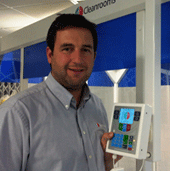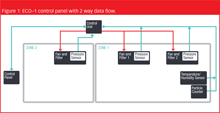Defining The Right Cleanroom Post Monitoring Programme
When it comes to monitoring the cleanroom, too much emphasis is often directed at the annual check, but ongoing monitoring is also crucial.
This article is part of a special feature on cleanrooms that was published in the December issue of PTE Digital, available at http://www.pharmtech.com/ptedigital1210.
Post monitoring of cleanrooms is determined by two main factors. The first is statutory requirements or regulatory compliance, such as ISO 14644 Parts 1 and 2 and the EU GGMP (European Union Guide to Good Manufacturing Practice). The second factor is built around the needs and expectations of the cleanroom, and the type of test and interval periods can vary.
To comply with ISO14644–2, particle counts need to be tested every 12 months as a minimum, with the exception of levels below class 5, which should be tested every 6 months. In addition to these, test air velocity and volume should be tested. Other typical optional tests are smoke visualisation, filter integrity and recovery rates. The period for these tests is suggested as a minimum of 24 months.

Joe Govier. Managing Director at Connect2Cleanrooms.
This mandatory compliance as an ongoing process is similar to the requirements of a car needing an annual MOT (car safety test); success or failure informs you whether your car or cleanroom is working or not.
Treat your cleanroom as you would your car
Taking this analogy of the MOT, if you use your car on a daily basis and its function is critical to you getting to and from work, if you came out to it in the morning and found a flat tyre, you would repair it before going on your journey. The form of monitoring is a quick look at the car before setting off and is done as a matter of course. You would not consider continuing to drive until the next MOT.
The logic above seems simple; however, when it comes to monitoring the cleanroom, it is often overlooked and too much emphasis is directed to the annual check. This being the case, emphasis needs to be shared with the ongoing monitoring on either a daily or continuous basis.
The various tools or tests for the more continuous process and assessing if the cleanroom is ‘fit for purpose’ include:
- filter pressure gauges testing to ensure airflow
- room pressure gauges testing to ensure outward airflow
- particle counting using a laser particle counter for conformity to ISO14644–1
- air velocity using a vane anemometer to determine direction of flow and air changes.
Other environmental parameters such as temperature, humidity, noise and lighting levels can also be performed within these routine tests as appropriate. The bias of cleanroom monitoring is predominantly covered by these environmental parameters because they are tangible and measurable. The major factors that affect these results, however, are not as tangible and are mainly influenced by people and activities in the cleanroom. As such, it is not unreasonable to monitor these factors together with the environmental tests. These can form part of the existing quality system and cover cleanroom training, cleanroom cleaning and product/materials suitability for use in the cleanroom.
The solution is to use a post monitoring process that covers all points — not just compliance — and ensure the room is fit for the intended purpose at all times.
The annual validation process should be there to confirm that the continuous process is working and at no time should the system fail this check. If this occurs, it is too late and the consequence of this failure can have a far‑reaching impact on the business.

Figure 1: ECOâ1 control panel with 2 way data flow.
Cleanroom control and monitoring systems
A cleanroom control system needs to be distinguished from a cleanroom monitoring system. A monitoring system covers elements of the above where as a control systems in general are an addition to the air handling units, HVAC or filter fan units. All these systems are designed to deliver a fixed volume of HEPA filtered air creating the over pressure and air changes required. The variable parameters in this process can be fan speed and variable dampers either to add over pressure or relieve pressure, together with temperature and humidity control where required.
Your control system, however, should not be limited to airflow and temperature. Where possible, a closed loop system that can vary air speeds in relation to the particles per volume of air, control lighting levels and recording the operatives as they enter and exit the room is a more complete system. Systems such as the ECO–1 (Efficient Cleanroom Operations) are designed to do just this (Figure 1 and 2):
- variable air changes
- night to day cost saving
- particle monitoring
- alarm output
- validation/service reminders
- lighting controls
- operator log in and log out.
The combined cleanroom control system utilising data provided from the monitoring equipment and recording parameter changes is the pinnacle of cleanroom control, which can also reduce power consumption, reducing running costs and improving product confidence.

Figure 2: ECOâ1 control panel driving multiple zones with varying air flows.
HEPA filter selection criteria
Factors involved in selecting HEPA filters vary and depend on the location of the HEPA, the class of cleanroom and the pressure of the airflow to deliver the required volumes of air.
HEPA filters are the most common method of filtering the air into the cleanroom, and removing particles and microorganisms. The filter efficiency is normally no lower than 99.97% efficient at removing particles equal to 0.3 µm. The filter media is a glass fibre arranged in a random manor with the diameter of the fibres ranging from 0.1 µm to 10 µm.
To ensure the correct grade of filters, the European Standard (EN 1822) has classified filters with a range from H10 to U17. The typical grade for a standard HEPA is H13 OR H14; this type being suitable for cleanroom classes from ISO Class 6 up to Class 8. For classifications of Class 5 and cleaner, a ULPA (Ultra Low Particulate Air) filter is used. These are classified with a ‘U’ prefix in place of a ‘H’ and typically a U15 OR U16 is used.
Once the correct filter is selected, the fitting or sealing of the filter in its framework is critical. Various methods such as knife‑edge seal in to a soft silicon material or a closed cell foam gasket seal can be used. The testing of the filter also incorporates the seal so great emphasis should be paid to this when fitting and testing.
Room for improvement
Innovation in cleanroom monitoring now needs to use the data provided from monitoring technologies to further improve efficiency of the cleanroom and its impact on the environment. To date, the process has been an overkill and a ‘one sizes fits all’ approach often being based on an individual’s experience that has been seen over time as ‘best practice’.
Just as we have improved energy efficiency within our homes with low voltage light bulbs, better insulation, heating systems with timers and individual control from room to room, we can significantly improve the energy consumption of cleanrooms by reducing air speeds when room activity is low or nil.
In addition to the monitoring data, we are able to have better operational practices and cleaning processes to reduce the contamination generated; thus allowing lower air changes and lower power consumption. This can still be done whilst achieving the needs of ISO14644–1.
The biggest challenge and opportunities for the future are for quality and regulatory personnel to work with industry to develop realistic cleanroom guidelines that are efficient and fit for purpose.
Drug Solutions Podcast: A Closer Look at mRNA in Oncology and Vaccines
April 30th 2024In this episode fo the Drug Solutions Podcast, etherna’s vice-president of Technology and Innovation, Stefaan De Koker, discusses the merits and challenges of using mRNA as the foundation for therapeutics in oncology as well as for vaccines.
Pharmaceutical Tariffs Are Imminent: How Industry is Bracing for Impact
April 16th 2025On April 14, 2025, the Trump Administration launched a national security-driven investigation into pharmaceuticals, a move that will likely result in tariffs being placed on pharmaceutical drugs, ingredients, and other components that are imported from outside of the United States.